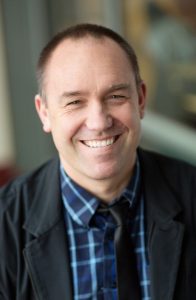
Bonnie Ashmore and Sam Peck believe that for artists, improvisation is key.
“I think that one of the big lessons of art making is just becoming comfortable with the unknown. … You never know what something is going to look like when you start making it,” Ashmore said.
When it comes to teaching art, they apply the same thinking.
“You never know how the day is going to go or how your kids are going to be when they walk into your classroom,” Peck said. “You have to be comfortable in, and ready for, any situation.”
Ashmore and Peck are artists and educators at the School of Art. They run the Young Artists Special Studies program, teaching students from ages 6 to 17, as well as leading workshops in printmaking for students and emerging artists at the School of Art.
They will be giving a joint lecture at 7 p.m. Friday, July 5 in the Hultquist Center, as part of the Visual Arts Lecture Series.
Peck is a Ph.D. candidate in arts education at the University of Minnesota. He will speak on his teaching philosophy, as well as how his experiences as a sexual assault survivor and a member of the U.S. military have influenced his art and teaching.
“(These experiences) inform the way that I teach to make sure that I have the best and safest experience for my
students,” he said.
Peck is teaching 12- to 17-year-olds; this is his first season at Chautauqua Institution, and he said his experience has been “incredible” so far.
He enjoys that the Institution is a place where people allow themselves to be “uncomfortable with unknowing.”
“Someone’s going to poke a hole in the bubble of your thought process (and) kind of deflate you a little bit, but now you shift to expand and accept that new knowledge,” he said.
Ashmore has taught in Massachusetts public schools for 20 years, and has an artistic practice of her own. This is her seventh season teaching at Chautauqua, where she’s in charge of 6- to 11-year-olds in the Young Artists Special Studies program.

She will also be discussing her artistic practice, particularly a series called “Origins,” which features paintings based on the chemical structures of chemotherapy medications. As a breast cancer survivor, this was a deeply personal project for Ashmore.
“I took all the medications that I focused on,” she said.
Ashmore said she and Peck both started as artists before becoming educators, something which has influenced their approaches to teaching.
“I know that an artistic practice is a lifelong practice,” she said. “That’s really what I want to instill in (students); that this is something you can do forever. … It’s so great; it’s a gift in that way because you’ll always have work that you can do. So, it’s less about the individual project and more about the process.”
Ashmore and Peck seek to instill creativity and independence in their students by giving them control over the direction of their work.
“(If) you’re saying, ‘We’re all going to paint Picasso-like pictures,’ or, ‘Everybody’s going to paint sunflowers,’ is it really a choice?” Peck said. “Or are we actually just asking them to reproduce somebody’s work who has been dead for more than 100 years?”
They aim to strike a balance between giving their students creative freedom and offering them professional guidance.




